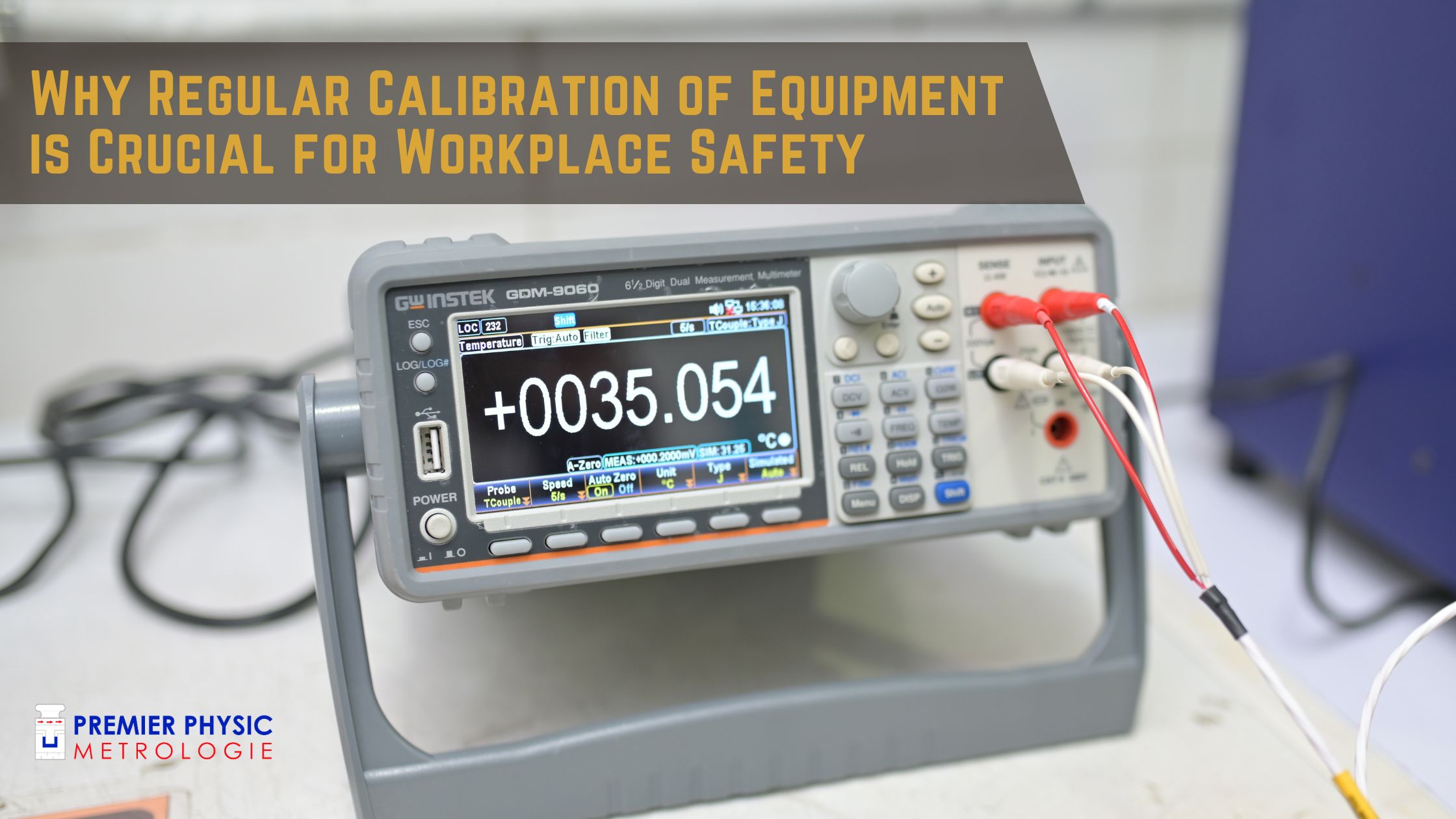Introduction
Workplace safety is paramount in any industry. Ensuring a safe working environment not only protects employees but also preserves the integrity of operations and safeguards company reputation. One critical aspect of maintaining workplace safety is the regular calibration of equipment. But why is this process so crucial?
Understanding Equipment Calibration
Before delving into the importance of regular calibration, it’s essential to understand what calibration entails. Calibration is the process of comparing a device’s measurements to a known standard to ensure accuracy. Whether it’s a scale in a laboratory or a pressure gauge in a manufacturing plant, accurate measurements are vital for proper functioning and safety.
Why Regular Calibration of Equipment is Crucial for Workplace Safety:
Regular calibration of equipment forms the cornerstone of maintaining a safe working environment. By ensuring that machinery and instruments perform optimally, calibration mitigates potential hazards and prevents accidents. This section explores the multifaceted importance of this practice.
Calibration guarantees accuracy: Accurate equipment is vital for safety protocols. Whether it’s measuring temperature, pressure, or chemical compositions, precise readings are essential for identifying potential risks and implementing necessary precautions.
Enhanced reliability: Calibrated equipment operates reliably, minimizing the likelihood of malfunctions or breakdowns that could pose safety threats. Reliable machinery fosters trust among workers and reduces the chances of workplace accidents.
Prevention of costly errors: In industries where precision is paramount, even minor deviations can lead to significant consequences. Regular calibration helps detect and rectify errors before they escalate into costly mishaps, safeguarding both personnel and resources.
Compliance with regulatory standards: Adhering to regulatory requirements is non-negotiable in ensuring workplace safety. Many industries are subject to stringent regulations mandating regular equipment calibration to uphold safety standards and protect workers’ welfare.
The Process of Equipment Calibration:
Calibration isn’t a one-time task; it’s an ongoing process that demands meticulous attention to detail. Here’s an overview of the calibration procedure:
- Assessment of Calibration Needs:
- Identify equipment requiring calibration based on usage frequency, criticality, and industry standards.
- Prioritize instruments vital for safety-critical processes.
- Selection of Calibration Standards:
- Choose appropriate calibration standards, ensuring they align with regulatory requirements and industry best practices.
- Calibration Execution:
- Engage qualified technicians or utilize accredited calibration services to conduct the calibration process.
- Follow manufacturer guidelines and established procedures meticulously.
- Documentation and Traceability:
- Maintain comprehensive records documenting calibration dates, results, and any adjustments made.
- Ensure traceability of calibration standards to uphold the integrity of the calibration process.
Benefits of Regular Equipment Calibration:
The advantages of regular equipment calibration extend beyond mere compliance. Here are some compelling benefits:
- Risk Mitigation: Regular calibration identifies and mitigates potential safety risks, fostering a secure work environment.
- Enhanced Productivity: Reliable equipment minimizes downtime due to malfunctions, optimizing operational efficiency and productivity.
- Quality Assurance: Accurate measurements and consistent performance uphold product quality standards, enhancing customer satisfaction and brand reputation.
- Cost Savings: Proactive maintenance through calibration reduces the likelihood of costly repairs or replacements, translating into long-term cost savings.
- Employee Confidence: A culture of safety cultivated through regular calibration instills confidence in employees, boosting morale and job satisfaction.
Risk Mitigation
Calibration plays a crucial role in risk mitigation within the workplace. By identifying and correcting inaccuracies in measurements, calibration helps prevent potential hazards. Whether it’s in a medical setting where dosage accuracy is critical or in a construction site where weight limits must be adhered to, calibrated equipment reduces the likelihood of accidents and injuries.
Furthermore, regular calibration helps prevent equipment malfunction and failure. By detecting issues early on, such as sensor drift or component degradation, calibration allows for timely maintenance and repairs, thus avoiding costly downtime and potential accidents.
Cost Savings
Investing in regular calibration ultimately leads to cost savings for businesses. By avoiding unexpected breakdowns and prolonging the lifespan of equipment, companies can reduce maintenance costs and mitigate the need for costly replacements. Additionally, by minimizing errors and rework through accurate measurements, calibration enhances operational efficiency, further contributing to cost savings.
Improved Productivity
Accurate equipment translates to improved productivity. When measurements are precise and reliable, operations can run smoothly without disruptions caused by faulty equipment. Employees can focus on their tasks without having to worry about the accuracy of the tools they rely on, leading to increased efficiency and output.
Types of Equipment Requiring Calibration
Calibration is applicable across various industries and a wide range of equipment. From medical devices like blood pressure monitors to industrial machinery like torque wrenches, any equipment that relies on accurate measurements should undergo regular calibration.
Calibration Frequency Guidelines
The frequency of calibration depends on several factors, including the type of equipment, its usage, and environmental conditions. While some equipment may require calibration on a monthly basis, others may only need it annually. Following manufacturer recommendations and industry standards is crucial in determining the appropriate calibration intervals.
Calibration Process
The calibration process typically involves comparing measurements from the equipment to known standards and making necessary adjustments to ensure accuracy. It’s essential to entrust calibration to certified technicians who have the expertise and equipment to perform precise calibrations.
Documentation and Record-Keeping
Maintaining accurate records of calibration activities is essential for compliance and traceability. Detailed documentation allows businesses to track equipment performance over time, identify trends, and schedule maintenance proactively.
Common Challenges in Calibration
Environmental factors such as temperature and humidity can affect calibration accuracy. Additionally, normal wear and tear on equipment components can lead to drift over time, necessitating regular adjustments.
Signs That Equipment Needs Calibration
Changes in measurement accuracy or unusual behavior from equipment are indicators that calibration may be necessary. It’s crucial for employees to be vigilant and report any discrepancies promptly to prevent safety risks.
Best Practices for Successful Calibration
Regular inspections and preventive maintenance are key to successful calibration programs. Investing in quality calibration equipment and providing comprehensive training to staff ensures that calibration processes are conducted effectively and efficiently.
Training and Education
Employee training is vital in ensuring awareness of calibration procedures and fostering a culture of safety within the workplace. By educating staff on the importance of calibration and how to recognize signs of equipment malfunction, companies can mitigate risks and promote a safer working environment.
Conclusion
In conclusion, regular calibration of equipment is indispensable for maintaining workplace safety. By ensuring accuracy, reliability, and compliance with regulations, calibration plays a pivotal role in risk mitigation, cost savings, and improved productivity. Businesses that prioritize calibration invest in the safety and efficiency of their operations, ultimately contributing to their long-term success.
FAQs
- How often should equipment be calibrated?
- The frequency of calibration depends on factors such as equipment type, usage, and industry standards. It’s essential to follow manufacturer recommendations and regulatory requirements.
- What are the consequences of not calibrating equipment?
- Failure to calibrate equipment can lead to inaccurate measurements, potential hazards, and compliance issues. It may also result in costly downtime and compromised product quality.
- Who should perform equipment calibration?
- Calibration should be conducted by certified technicians with the necessary expertise and equipment to ensure precise measurements and compliance with standards.
- Can calibration prolong the lifespan of equipment?
- Yes, regular calibration can help identify issues early on, allowing for timely maintenance and repairs that can extend the lifespan of equipment and reduce the likelihood of breakdowns.
- How can businesses ensure compliance with calibration requirements?
- Businesses can ensure compliance by maintaining accurate calibration records, following industry standards and regulations, and conducting regular audits of their calibration processes.




